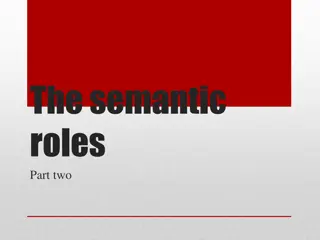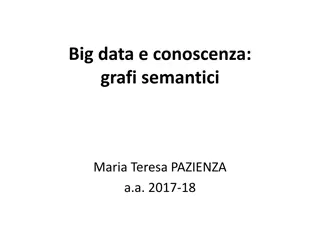Understanding Semasiology: The Study of Word Meaning
Semasiology is a branch of linguistics focused on the meaning of words. It delves into various aspects of lexical meaning, semantic development, polysemy, and semantic structure. Through exploring types of word meanings and semantic changes, semasiology helps us comprehend the intricate nuances of l
4 views • 19 slides
Understanding Semantic Memory Models in Cognitive Psychology
Explore the structure and processes of semantic memory through traditional and neural network views. Delve into symbolic and network models, such as Collins & Quillian's 1970 model, which organize concepts as nodes and links, depicting relationships between concepts within semantic memory representa
1 views • 78 slides
Understanding Semantic Roles in Linguistics
Semantic roles, also known as theta roles, play a crucial part in understanding the relationships between participants and verbs in a sentence. They include agents, experiencers, causers, positioners, subject complements, and objects. Agents are typically the doers of actions, experiencers receive e
1 views • 18 slides
Understanding Semantic Roles in Sentence Structure
Semanticists analyze sentences based on semantic structure rather than traditional syntactic terms like subject and object. Instead, they use semantic terms such as Agent, External causer, Instrument, Affected, Recipient, and Locative. These terms help describe how people and things participate in r
1 views • 26 slides
Gender Pay Gap Analysis and Parity Initiatives in City of Harare
The City of Harare has sex-disaggregated data on employment showing disparities in earnings between men and women. The average monthly earnings for full-time and casual positions reveal a gender wage gap of 0.96%. Reasons for this gap include job segregation and manual labor preferences, affecting w
1 views • 8 slides
Semantic Analysis of Clinical Narratives Using Complex Knowledge Graphs
Need for improved semantic analysis of clinical narratives for information retrieval and decision support is addressed through the use of complex knowledge graphs. These graphs capture axiomatic descriptions of generalizable truths about entities in the medical domain, providing a language-independe
0 views • 8 slides
Understanding Semantic Properties in Lexical Semantics
Explore the concept of semantic properties in lexical semantics through examples involving word meanings and relationships. Learn how semantic properties form the basic building blocks of language construction, sharing common attributes among words while also showing contrastive distinctions. Dive i
0 views • 17 slides
Evolution of Semantic Field Theory in Linguistics
The theory of semantic fields, also known as field-theory, originated in the 1920s and 1930s with German and Swiss scholars. J. Trier and L. Weisgerber further developed this theory post World War II, associating it with the Language and Society movement. Trier's approach focused on comparing the st
0 views • 20 slides
Exploring the Benefits of Taking a Gap Year After High School
Discover the various opportunities and benefits of taking a gap year post-high school, including insights from counselors and graduates, options for programs like academic courses, community service, and travel experiences, along with suggestions on how to start and what questions to ask when consid
0 views • 11 slides
Understanding the Importance of Semantic HTML Tags
In this lecture, we delve into the significance of semantic HTML tags in structuring web content. We explore when to use
2 views • 9 slides
Exploring Semantic Web Technologies: RDFa, GRDDL, and POWDER
Delve into the depths of Semantic Web technologies with a focus on RDFa, GRDDL, and POWDER through the guidance of Dr. Nicholas Gibbins. Learn about embedding Semantic Web data, republishing embedded data, and the usage of GRDDL for XML transformations.
13 views • 38 slides
Understanding Semantic Properties of Verbs in English Language
Explore the semantic properties of English verbs through various examples and classifications. Discover how verbs like hit, kiss, and touch share common properties, while verbs like make, create, imagine, and build belong to different classes based on their semantic relationships. Delve into the gra
0 views • 17 slides
Semantic Web Technologies and Knowledge Representation Overview
Semantic Web technologies such as RDF, RDFS, OWL, and SPARQL form the basis of a web of data designed for machine understanding. Knowledge representation languages play a crucial role in AI, with Semantic Web languages like OWL leading the current generation. Contrasting database and knowledge base
0 views • 50 slides
Dynamic Semantic Parser Approach for Sequential Question Answering
Using a Dynamic Semantic Parser approach, the research focuses on Sequential Question Answering (SQA) by structuring queries based on semantic parses of tables as single-table databases. The goal is to generate structured queries for questions by defining formal query languages and actions for trans
0 views • 23 slides
Sample Fit-Gap Kick-Off Approach for Agencies
Illustration of how agencies can develop a fit-gap approach, manage stakeholders, and identify capability gaps through a Sample Fit-Gap Kick-Off guided by M3 Playbook Lessons Learned. The kick-off includes assessing requirements, developing a detailed approach with a BPR statement, and using live de
0 views • 9 slides
Understanding Semantic Effects in Verbal Short-term Memory
Investigating the impact of semantic knowledge and similarity on verbal short-term memory, this study delves into how imageability of words influences recall. Key findings highlight the influence of semantic relatedness and the imageability effect on memory retention, shedding light on the mechanism
0 views • 47 slides
Unveiling Polarity with Polarity-Inducing Latent Semantic Analysis
Polarity-Inducing Latent Semantic Analysis (PILSA) introduces a novel vector space model that distinguishes antonyms from synonyms. By encoding polarity information, synonyms cluster closely while antonyms are positioned at opposite ends of a unit sphere. Existing models struggle with finer distinct
1 views • 29 slides
Multimodal Semantic Indexing for Image Retrieval at IIIT Hyderabad
This research delves into multimodal semantic indexing methods for image retrieval, focusing on extending Latent Semantic Indexing (LSI) and probabilistic LSI to a multi-modal setting. Contributions include the refinement of graph models and partitioning algorithms to enhance image retrieval from tr
1 views • 28 slides
Semantic Data Model of Electronic Invoicing Core Elements
Presentation by Fred van Blommestein on the EN16931-1 semantic data model of core elements in electronic invoicing, covering invoice processes, core invoice design, semantic model details, business rules, and invoicing principles. The model includes 160 elements in 33 groups, with mandatory elements
0 views • 13 slides
Understanding Gender Pay Gap Report at Abbeycroft Leisure
Gender Pay Gap (GPG) Report at Abbeycroft Leisure reveals a mean gender pay gap of -13.52% and a median gap of -3.81%. While women earned more on average than men, there was no bonus gender pay gap due to no bonuses paid in the relevant period. The composition of the workforce, bonus gender pay gaps
0 views • 7 slides
Gender Pay Gap Data Analysis at NICE - 2022/23
Delve into the gender pay gap data analysis at NICE for the reporting period of 2022/23, highlighting a mean gender pay gap of 7.36%, improvements in gender equality, disparities faced by women, and plans for further reducing the gap in 2024.
0 views • 10 slides
Revisiting Semantic Feature Analysis: A Classic Therapy Technique
Aphasia often involves semantic breakdown, and Semantic Feature Analysis (SFA) is a foundational technique for various treatments addressing semantic impairments. This presentation explores the effectiveness of SFA in improving naming, generalization to spontaneous speech, and treatment goals beyond
0 views • 16 slides
Integrated Reporting Workshop Wrap-Up and Next Steps
The workshop on integrated reporting held on 1st December 2022 focused on enhancing proposals, planning JBRC setup, data dictionary governance, semantic integration, and more. The roadmap for 2023 includes topics like data granularity, governance, and continuous work on semantic and syntactic layers
0 views • 4 slides
Gender Pay Gap Report for Linley & Simpson Ltd: Insights and Commitments
This report presents the gender pay gap data for Linley & Simpson Ltd as of 5th April 2022, highlighting a 46% ordinary pay gap and detailing efforts towards aligning pay for jobs of equal value. The company emphasizes fair pay, diversity, inclusion, and development opportunities. Factors impacting
0 views • 6 slides
Bridging the Semantic Gap in Gradual Programming
Observing a disconnect between programmer intent and program meaning, Gradual Programming by Bor-Yuh Evan Chang, Amer Diwan, and Jeremy G. Siek explores tools' lack of knowledge in understanding programmers' priorities, hindering productivity and reliability. Through examples like iteration orders a
0 views • 8 slides
Semantic Relations Expressed by Prepositions in Modeling Study
Explore the study on modeling semantic relations expressed by prepositions conducted by Vivek Srikumar and Dan Roth from the University of Illinois, Urbana-Champaign. The research delves into prepositions triggering relations, ontology of preposition relations, examples of preposition relations, pre
0 views • 25 slides
Gender Pay Gap Analysis and Action Plan for 2023
The gender pay gap persists, with women earning significantly less than men due to various factors including caring responsibilities, low-skilled jobs, part-time work, and discrimination. In 2023, the national median pay gap stands at 9.4%. NHS Gloucestershire ICB has reported a mean gender pay gap
0 views • 7 slides
Ensembling Diverse Approaches to Question Answering
Diverse types of question answering approaches include factoid querying, compositional querying of structured databases/knowledge graphs, reading comprehension, and visual question answering. Limitations of factoid question answering are also discussed, highlighting the need for specific queries and
0 views • 28 slides
Annotating Semantic Issues in Translation for Students
This chapter delves into semantic issues in translation, aiming to assist students in annotating their translations from a semantic viewpoint. It emphasizes using semantic information to aid in translating data accurately while maintaining communicative effectiveness. The story discussed highlights
0 views • 19 slides
Understanding Poverty, Racial Wealth Gap, and Tax Fairness
This training program is designed to review basic information on poverty, inequality, and the racial wealth gap, understand the creation and perpetuation of the racial wealth gap, learn about policy tools to narrow the gap, and empower individuals to take action towards ending hunger and poverty. Th
0 views • 52 slides
Semantic Classification of Prepositions in Bulgarian WordNet: A Comprehensive Overview
This presentation delves into the semantic classification of prepositions in the BulTreeBank WordNet, focusing on the incorporation of prepositions, closed-class words, and the benefits for neural model building in Bulgarian language processing. The motivation behind the study, challenges posed by p
0 views • 7 slides
Gender Pay Analysis at Savills Management Resources Ltd
The 2018 Gender Pay Gap analysis for Savills Management Resources Ltd reveals a mean hourly full pay gap of -1.3% and a median hourly full pay gap of -12.3%, both favoring female employees. However, the mean bonus pay gap slightly favors male employees by 0.1%, while the median bonus pay gap favors
0 views • 4 slides
Gender Pay Gap Report 2023: Sherry Fitzgerald Analysis & Actions
The Gender Pay Gap Report 2023 by Sherry Fitzgerald reveals a 29% mean gap and a 30% median gap in hourly remuneration between men and women, showing improvement from the previous year. The report highlights the distribution of male and female employees across pay quartiles and bonus remuneration pe
0 views • 6 slides
Semantic Technologies for Data Management and Knowledge Extraction
An exploration of how semantic technologies facilitate data management, knowledge extraction, and understanding in the realm of big data. Topics covered include semantic graphs, content information extraction, and the impact of semantic models on enhancing data value and relationships. The importanc
0 views • 38 slides
Requirements for Semantic Biobanks and Global Biobank Data Retrieval
Explore the critical aspects of semantic interoperability in biobanking, highlighting the need for formal ontologies, comprehensive annotations, and model of meaning data. The (Generalized) Biomedical Retrieval Scenario underscores the importance of effective resource retrieval based on content-base
0 views • 16 slides
Exploring Binary Representation and Semantic Approaches in Data and Programs
Delve into the fascinating realm of binary representation and semantic approaches in data and programs through a series of discussions and examples. Topics include encoding/decoding relevance, tamper-proof bytecode formats, incorporating semantic info for compact encodings, and playing guess-who gam
0 views • 21 slides
Understanding the Effects of Air Gap Tolerance on Inductance Tolerance
This technical note delves into the impact of air gap tolerance on inductance tolerance in transformer manufacturing. It explains how controlling the core's air gap dimension is crucial for maintaining desired inductance levels within manufacturing constraints. The text discusses the small scale of
1 views • 10 slides
Gender Pay Gap Report Summary as of 31st March 2023
The Gender Pay Gap Report as of 31st March 2023 for Oxford Health NHS FT highlights the difference in average earnings between men and women. Employers with 250 or more employees are required to comply with gender pay gap reporting regulations. The report includes data and calculations for mean and
0 views • 11 slides
Advances in Neural Semantic Parsing
Delve into the realm of neural semantic parsing with a focus on data recombination techniques, traditional parsers, and the shift towards domain-general models. Explore the application of sequence-to-sequence models and attention-based neural frameworks in semantic parsing tasks. Discover the evolvi
0 views • 67 slides
Understanding RDF Schema: A Deep Dive into Semantic Web
In this detailed exploration of RDF Schema, Dr. Nicholas Gibbins covers topics such as defining classes and properties, subclass relationships, semantic implications, reflexive properties, type distribution, and property definitions in RDF. Learn about the essential aspects of RDF Schema and its rol
0 views • 19 slides







































